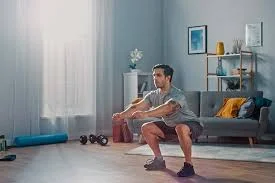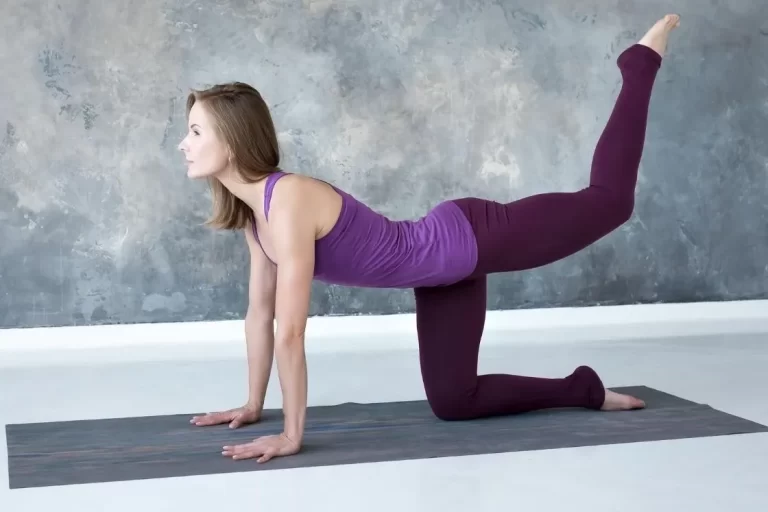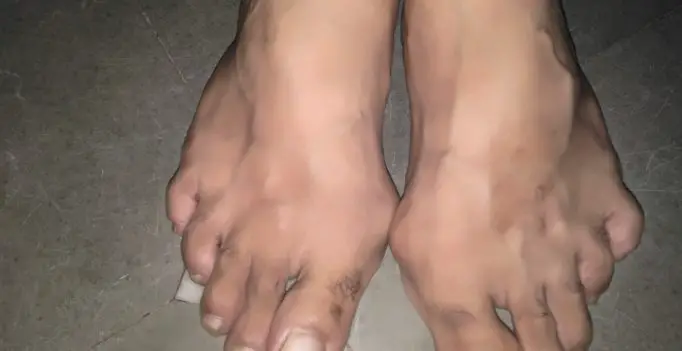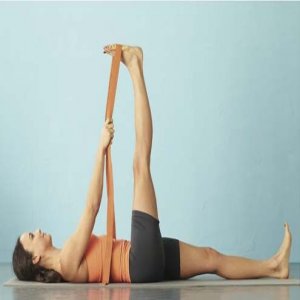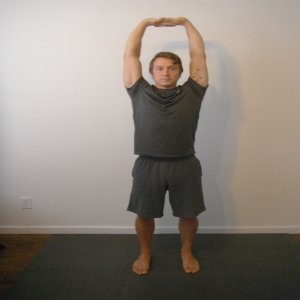Quadriceps Home Exercises: Build Strength and Power
Introduction
Quadriceps home exercises are a great way to strengthen and tone the muscles on the front of your thighs. Strong quadriceps are important for many activities, such as walking, running, jumping, and squatting. They also play a role in knee stability and injury prevention.
There are many different quadriceps home exercises that you can do with no special equipment
How Do Quad Exercises Work?
Exercises for the quads focus on the rectus femoris, vastus lateralis, vastus medialis, and vastus intermedius, the four muscles in the front of your thigh. They aid in raising the thighs and straightening the knees. Hip flexion is improved and regular lower body actions are made easier thanks to strong quadriceps. For quadriceps workouts to grow muscle mass and make the quads stronger, it takes time, effort, and discipline.
All four muscles that make up the quadriceps (quad) muscle group are worked out in the best quadriceps exercises. Your quadriceps, which are situated at the front of your thigh, cooperate to elevate the thigh and extend and straighten the knee. You can walk, run, leap, squat, and climb stairs more easily with strong quadriceps because they improve knee stability and hip flexion.
At the front of the leg, there are four muscles collectively known as the quadriceps. They are in charge of extending the knee and supporting the patella’s (kneecap) stability. There are several reasons why having strong quadriceps muscles is beneficial, including:
- strengthened knee stability
- reduced risk of knee injuries
- improvement of athletic performance
- simpler daily motions
Here are some pointers for safely and effectively performing quadriceps workouts at home:
- Before each workout, warm up by jogging, walking, or performing simple dynamic stretches.
- To prevent injuries, concentrate on good form.
- Through each exercise, take slow, even breaths.
- Each exercise should be performed a few times at first, and as you gain strength, you can gradually increase the number of repetitions.
- Pay attention to your body’s signals and stop any exercise that hurts.
- After each workout, cool down with a few simple static stretches.
The majority of quad workouts are quite easy for beginners and don’t call for specialized equipment.
Your quads are an important muscle group to focus on whether you’re a beginner at training or a seasoned athlete. These muscles are used for anything from standing up from a chair to walking or running.
By maintaining your quad’s strength, you can lessen the strain placed on your knees and improve the stability of your kneecaps. Your athletic performance can be enhanced in a variety of ways.
Fortunately, it doesn’t take much to put together a quad exercise program. You may work this muscle group quite slightly by using only your body weight.
Benefits Of Exercises For Quad Strength
Your quads, often known as your quadriceps, are made up of the following four muscles:
Rectus femoris. The primary muscle that helps in hip flexion, this muscle extends from your hip bone to your kneecap.
Vastus lateralis. This muscle runs down the outside of your thigh and is the biggest of the four quad muscles. It joins your kneecap to your thighbone.
Vastus medialis. This muscle, which can be found on the front of your thigh, stabilizes your kneecap and extends your knee.
Vastus intermedius. This muscle, which is situated between the other two vastus muscles on the front of your leg, is also utilized to extend your knee.
Regularly performing quad-strengthening workouts may facilitate improved hip and knee flexion and extension. Strengthening your quads can also help to protect your knee joint from harm and increase the stability of your kneecap.
you should jump higher.
Improve your overall athletic ability
improve your balance and stability and reduce the chance of knee osteoarthritis
make it simpler to do routine motions including walking, bending, and sitting.
In addition to making your quads stronger, quad-strength workouts have the following advantages:
- They let your knees extend more, making it easier for you to perform daily tasks.
- They lessen osteoarthritis patients’ knee discomfort and functional impairment.
- These workouts boost athletic ability.
- During jump landing, they raise jump height, knee flexion angle, and quadricep-spinal reflex excitability.
- They enhance the body’s stability and balance.
- They reduce the possibility of getting knee osteoarthritis.
The following exercises can all be done comfortably at home without any special equipment. Use dumbbells or large household items, such as books or water jugs, to make some of these workouts more difficult.
Getting started
Perform a warm-up program for at least 5 to 10 minutes before beginning the quad workouts described in this article. You can warm up with active walking, jogging, or dynamic mobility exercises like swinging your arms or legs.
For the majority of these exercises, beginners should start with 2 sets of 10–12 repetitions. You can increase the number of sets or reps as the exercises get easier to perform over time to make them harder.
The following are a few examples of quad workouts that work all four quad muscles:
- Bodyweight squat
- walking lunge
- step up
- Bulgarian split squat
- Lateral lunge (side lunge)
- Squat jump
- box jump
- Reverse lunge
- single leg raise
- Single-leg squat (pistol squat)
- splint squad isometric hold
- Single-Leg Box Squat
- wall seat
- one leg squat
- Curtsy Lunge
- squat walk
- Cossack Squats
While quad exercises are important for everyone, they are especially important for people who have balance problems and knee weakness as a result of aging, injury, lower leg or thigh surgery, or an orthopedic disease such as patellar tendinitis or iliotibial band friction syndrome.
Exercise For Quadriceps muscles, At Home:
SLR- Straight leg raise

The straight leg lift is a quick and easy exercise to activate your quad muscles. Here’s how you can do it.
the back straight, on a flat surface. Your unaffected leg—the one that wasn’t operated on or hurt—should have its knee bent at a 90-degree angle. Maintain a flat foot on the ground. Keep the other leg straight, knee not bent. Set your toes straight up at the ceiling.
By contracting the muscles at the front of the thighs, slowly raise the affected leg 12 inches off the ground. Take a 5-second hold.
Drop your leg gradually to the ground. Repeat 10 to 15 times while relaxing.
Things to keep in mind
Throughout this exercise, the knee of the lifted leg should remain completely straight. Utilizing the muscles in front of your hip joint, concentrate on lifting.
Want a more difficult task? Before you lift, put a 2- or 3-pound cuff weight on your ankle. Another option is to wrap a resistance band around each ankle.
Safety Advice
When you lift the knees, they should be straight.
Static Quadriceps exercise (SQE)
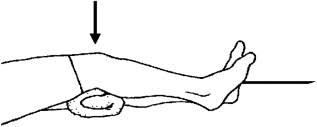
A wonderful method to concentrate on effectively contracting your quadriceps muscles is to perform the short arc quad exercise. Here’s how to go about it:
Lay down on your back. To support your knee, use a basketball or a yoga block/towel.
Lengthen your bent knee gradually until it is straight.
With your toes pointed upward, contract your quadriceps. Hold on firmly for five seconds.
Lower your leg gradually.
fifteen times.
Things to Consider
Make careful you raise and lower your leg slowly and steadily. Be sure to maintain contact with the bolster with the back of your knee. Try to tighten your quad and straighten your knee all the way when it is straight.
Be mindful of your body position to make the most of a simple arc. As you lift your leg, ensure your hips are parallel to the ground. Try to elevate your leg while drawing your hip down.
Additionally, you can increase the difficulty of this exercise by securing a tiny 2- or 3-pound cuff weight to your ankle.
Safety Advice
When you lift your legs, make sure your hips are lowered towards the floor.
Legs should be raised steadily and carefully.
Wall Slides – squat
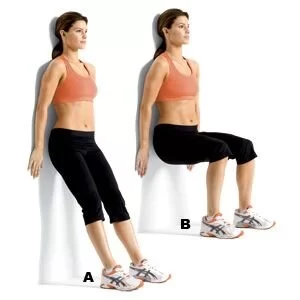
The quads, glutes, and hamstrings are just a few of the muscles your quad wall slide workout targets. Here’s how to go about it:
With your back against a wall and your feet shoulder-width apart, stand straight.
When your knees are at a 45-degree angle, slowly flex them while sliding your back down the wall for a count of five. Avoid bending past this point since doing so can strain your knees. For five seconds, maintain this posture.
Slide up the wall carefully, keeping your knees straight, until you are fully upright.
10 more times, repeat.
Remember to quit this exercise if you experience any discomfort or difficulty.
Things to keep in mind
Make sure you lower and raise yourself slowly and steadily. Keep in mind that squatting too deeply could put too much stress on your knees. Additionally, squatting too deeply can make it challenging to stand back up.
The exercise can be more difficult if you hold onto two dumbbells while performing the wall slide.
Safety Advice
Avoid bending too far because doing so will strain your knees.
Sliding back up, carefully raise yourself.
Bodyweight squat
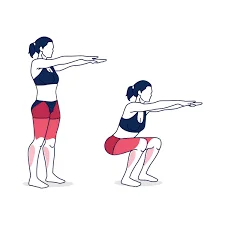
One of the best workouts for overall lower body and core strength is the bodyweight squat.
Bodyweight exercises like squats help to tone the lower body and strengthen the core. Try to make your squats more difficult each time you perform them to keep improving. This workout can be done anywhere, whether at home or the gym.
Reduce the depth of the squat to make the exercise easier if you immediately find it to be too difficult.
Quads, hamstrings, glutes, the core, and spinal erectors were all worked.
Instructions
With your toes pointing slightly outward, stand with your feet shoulder-width apart. You can clasp your hands in front of you, position your hands on your hips, or maintain your arms at your sides.
Push your hips back as if you were sitting in a chair while maintaining a strong core and a raised chest.
When your thighs are parallel to the floor, stop and take a moment to breathe.
Drive through your heels until you’re back in the starting position.
safety advice
Keep your knees from falling inward.
Don’t stoop any lower than you can without arching your back.
Keep your knees and feet in line as much as possible.
To avoid stress on the knee joints and tendons, maintain a straight line from your feet to your knees.
Avoid bending your back when performing squats
Things to keep in mind
Aim to keep your thighs and buttocks parallel to the floor when performing the chair pose. It might take some time. Try lowering your buttocks to the ideal position for a few seconds until you get there, and then relax back somewhat when the going gets tough. You’ll eventually arrive if you persevere and give it time.
Keep your buttocks above your knees. This can put extra strain on the knees and shift the resistance to the hamstrings
Walking lunge
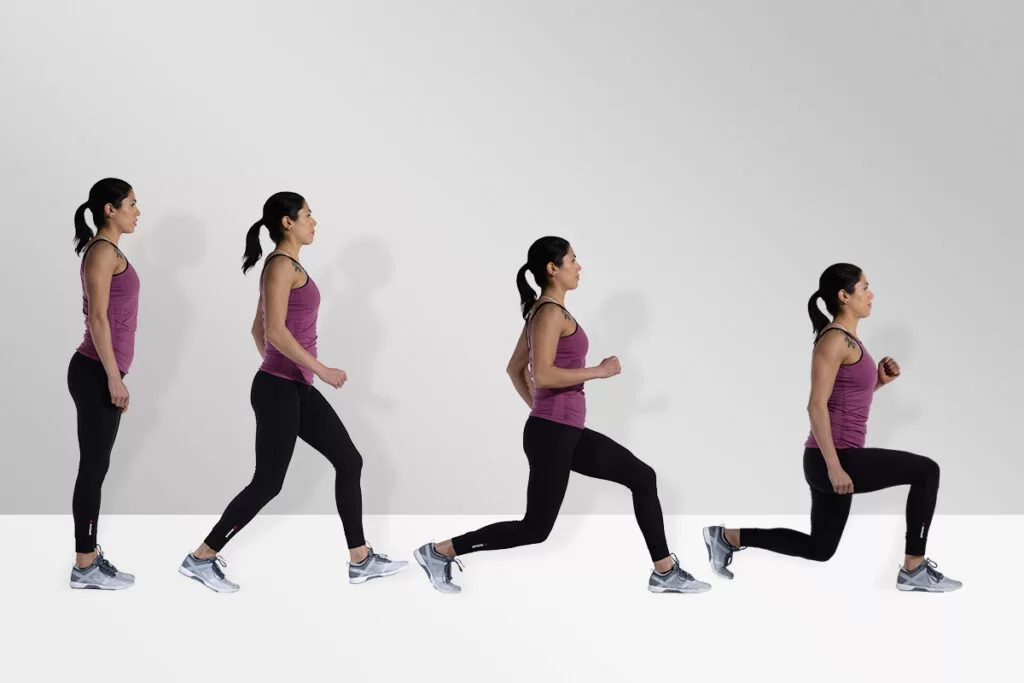
For individuals whose balance and knee strength have increased, this is a more challenging exercise. Lunges while walking exercise the core, hips, and glutes in addition to the legs.
The exercise should be performed on a flat area long enough to allow for 10 to 12 lunging steps while wearing a pair of solid walking shoes.
Making a walking lunge:
Stand upright with your feet shoulder-width apart. You can place your hands on your hips or at your sides. Your right leg should advance with a flat foot on the ground.
To lower yourself such that your right knee is bent at a 90-degree angle and your thigh is parallel to the ground, bend your right knee.
Step your left foot forward while maintaining your right leg’s position.
Ten to twelve repetitions of “walking” as you lunge on each leg should be completed.
Make two to three sets.
Things to keep in mind
When performing walking lunges, control must be maintained. Maintain a strong core, gently rolled shoulders, and erect posture. Hold your arms out to stabilize yourself if you ever feel unsteady.
Steps should not be excessively long (or short), as this can put excessive stress on your knees. To prevent damage when lunging, make sure your thigh and calf are at a 90-degree angle.
Safety Advice
To avoid straining your knees, avoid taking long steps.
Maintain a straight gait while walking to prevent unsteady shoulders.
Step-up with Leg Raise
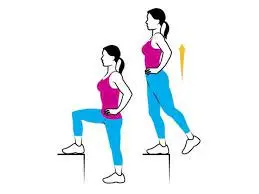
This is a fantastic at-home quad exercise that helps in knee stabilization and increases quad strength for the effortless performance of all daily activities. This exercise can assist with working out any muscular imbalances and helps you concentrate on one leg at a time.
The step-up is a great workout for hamstring and gluteal (hip and buttock) and quadriceps (quadriceps) strengthening.
You’ll need a strong platform, box, or bench that you can step up and down on for this workout.
The step-up exercise is performed as follows:
Place yourself six inches away from the bench, box, or platform.
As you stand up, press with the heel of your right foot to straighten your right leg. Bring your right foot and left foot together.
When you take a step back, bend your right knee and place your left foot gently on the ground.
With control, lower the right foot to the ground to touch the left foot.
eight to twelve times.
Steps 1 through 6 are repeated by switching legs.
You can raise the platform higher as you get stronger and/or grip a pair of weights in each hand.
Things to keep in mind
Use a very low step (6 to 8 inches high) when initially starting out, especially if you have stability concerns or are healing from an injury. For added stability, you can position the step next to a wall or the back of a sofa.
As you stand up, be mindful of your posture and contract your core muscles with each stride. Never should you need to “lunge” up. The step should be reduced if you feel the need to do so because it is too high.
Safety Advice
Step-ups should be performed on a solid surface.
Be sure to leave at least one hand free when using dumbbells.
Bulgarian split squat
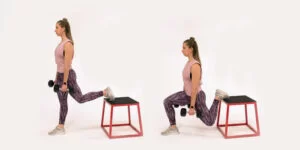
Compared to regular squats, Bulgarian split squats place greater attention on your knee and hip stabilising muscles. By merely going halfway down, you can make them simpler.
the quads, hamstrings, hips, and core muscles.
Instructions
Stand about two steps away from a bench, box, or other knee-high surface with your feet shoulder-width apart.
Place your front foot forward far enough to allow you to squat without your knee crossing your toes. One foot should be raised up on the object behind you. Lower yourself till your front thigh is nearly parallel to the floor while leaning slightly forward.
Repeat on your chosen side for the specified number of reps.
Repeat on your chosen side for the specified number of reps.
safety advice
Check to see if the thing behind you is sturdy and substantial.
Keep your knee from crossing your toes.
If you have any knee pain, stop.
Make sure your foot doesn’t stray too far from the bench.
Slowly perform the squats rather than jumping up and down quickly.
Side-lunge
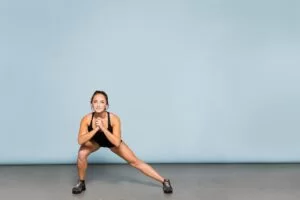
The lateral lunge assists in strengthening your inner thigh in addition to your quadriceps.
Quads, inner thighs, hamstrings, and glutes were exercised.
Instructions
Stand with your feet shoulder-width apart and your arms out in front of you to maintain your balance.
Take a big step to the right, begin to push your hips back, and bend your right knee to kneel.
Squat till your thigh is parallel to the floor or as low as you can go comfortably.
Once the other side is finished, return to where you started.safety guidance
Avoid taking actions that cause groin pain.
Keep your knee above your second and third toes when squatting.
Avoid twisting when returning to the starting position.
Lunges
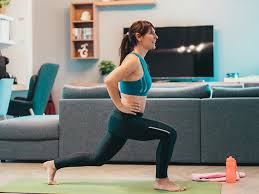
Lunges are an effective complement to your lower body workout since they increase your mobility and strength. This quad workout helps to shape and tone the quads. They can be done at home with dumbbells.
How to carry out
Stand with your arms at your sides while your feet hip-width. Dumbbells can also be used in each hand.
Step forward with one foot, then bend your lower leg so that it is parallel to the ground. Parallel to the ground should be the leg on the opposite side.
After holding for ten seconds, switch to the other leg.
For each leg, perform 2-3 sets of 10-15 reps.
Safety Advice
Avoid letting the floor contact your back knee.
Try to maintain toe-to-knee alignment.
Squat jump
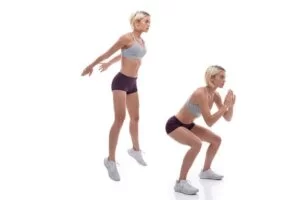
Squat jumps are a fantastic exercise for developing the strength in your lower body. You can begin this exercise with 5 reps each set rather than 10.
Legs, calves, glutes, and the core were all worked.
Instructions
As you kneel down with your feet shoulder-width apart, your hands should be in front of you.
Squat until you’re prepared to jump up quickly, with your thighs almost parallel to the floor.
Gently land with your knees slightly bent before repeating.
safety guidance
Squat jumps should not be performed if you have knee issues.
Make your landing as soft as you can by bending at the knees.
When you land, prevent your knees touch your toes.
Tuck jump
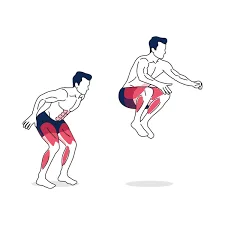
Another excellent workout for building lower body strength is box jumps. For this exercise, it’s better to limit yourself to 5 reps or less since as you tire, your chance of injury rises.
Quads, calves, glutes, and core muscles were worked.
Instructions
With your feet shoulder-width apart, stand about a foot away from a solid container or another firm surface.
After bending your knees and dropping your arms behind you, you should now be in a quarter squat.
Jump up onto the box with your hips extended and your arms swinging forcefully in front of you.
Your knees should be slightly bent when you land. Put greater restrictions on yourself.
safety guidance
Avoid box jumps if you have knee issues.
It is better to choose a box that is too low than one that is too high if you are a beginner.
Keep in mind to flex your knees to soften your leaps.
Safety Advice
Until you feel comfortable with the movement, pick a box with a lower height.
If you have an ankle, knee, hip, or other problem, do not attempt this exercise.
Alternating Reverse lunge

Reverse lunges are a type of traditional lunge that provides you additional stability in your lead leg, which helps you maintain balance. They can be made simpler by simply lunging halfway down.
quads, glutes, and core muscles were worked.
Instructions
Standing tall, place your hands on your hips or hold dumbbells at your sides.
Step back with one foot in a wide step. When you squat down, your lead thigh should be parallel to the ground. Your raised knee should almost touch the ground.
Push through your front heel as you take a stride back to the beginning position.
Repeat for the specified number of reps, changing sides each time.
safety advice
Do not let the floor contact your back knee. Stop if your knees start causing pain.
When lunging, keep your front knee over but not past your toes.
To avoid stretching your lower back, keep your core tight.
Quad strengthening exercises are excellent for improving lower body strength, but some people should not perform them.
Split Squat
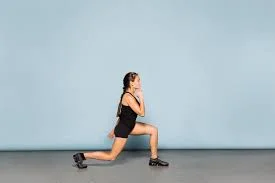
The split squat is a great quad workout that improves both your strength and general stability by stretching one leg while strengthening the other. You can perform this workout on a mat or a carpeted surface for comfort.
The split squat simultaneously stretches the quad and hip flexors of the rear leg while working the quads, glutes, and hamstrings of the front leg.
Split squat technique:
Place your back knee on the ground as you kneel. Your knee should be directly above your ankle and at a 90-degree angle as you plant your front foot on the ground.
With your front leg as nearly straight as you can, raise your body smoothly to a standing position. Pause.
With control, lower yourself to the beginning position by bending your knees.
position.
eight to twelve times.
Steps 1 through 4 are repeated while switching legs.
Things to keep in mind
If you’re just starting out, perform this exercise near to a chair or a wall so you have something to grip onto for balance your toes under your heels so that you are standing on the ball of your foot for more stability.
Check your foot position if you have knee pain; your forward foot may be either too far forward or too far back. Just travel as far as is comfortable for you.
while you build strength, you can tap your knee to the ground instead of letting it rest on the floor while you squat, then quickly push yourself up without resting. Do not, however, “bounce” or hurry as you climb and down.
The wall seat calf raise
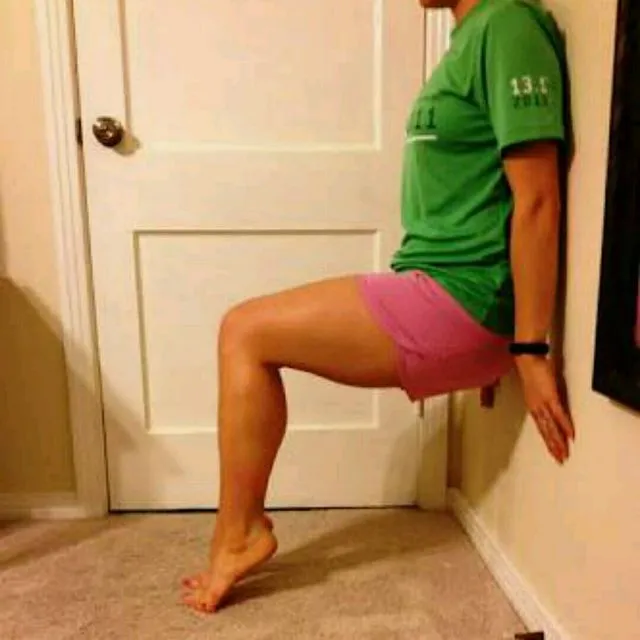
Wall sits are a great workout for building leg strength. The muscles in the buttocks, quads, hamstrings, and calves are used to complete this straightforward but powerful bodyweight exercise while leaning up against a wall.
The beauty of wall sits is that, despite being low-impact, they can greatly increase your lower body’s strength while strengthening your core and abdominal muscles.
Single-leg squats (pistol squats)
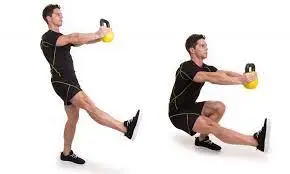
Single-leg squats are a fantastic workout that helps improve stability and mobility in the hip and knee joints while assisting in the development of power and strength. Hip Circle Bands work well for this functional exercise because they help strengthen the target muscles, which are mainly the glutes, quadriceps, hamstrings, and core while improving muscular balance.
A difficult squat variation that calls for strength, flexibility, and balance is the pistol squat. You can place a chair behind you to prevent yourself from squatting all the way down if you are unable to do so.
This exercise is not suitable for beginners. It’s advisable to only attempt this motion if you are confident performing the nine exercises before it.
quadriceps, glutes, core, and inner thigh muscles were exercised.
The difficulty of maintaining postural control and improving coordination during dynamic movements is another benefit of performing single-leg squats. After a few repetitions, your muscles will start to burn, but this workout will quickly make you feel stronger.
With the second leg raised off the ground, balance yourself on one leg.
Squat down while maintaining your knee behind your toe and your chest forward.
To stand again, push back up through your heel.
Continue with the opposite foot.
How to perform:
You should be standing with your back against a wall and your feet shoulder-width apart. Slide down until your knees are 90 degrees apart and your thighs are parallel to the ground.
As long as you can, keep this stance.
safety advice
If your knee hurts, stop.
Only go as far as you can without getting uncomfortable.
Only go as far as you can while maintaining control of your knee.
Squat to curtsy lunge
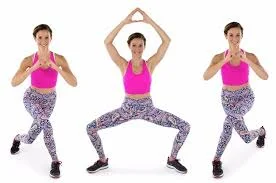
Why it rocks: This lunge variation hits your inner thighs and outer glute muscles more than most, in addition to your quads.
How to:
Start standing with feet hip-width apart.
Taking a large step back, cross your left leg behind your right side.
Once the right thigh is almost parallel to the floor, bend your knees and drop your hips. Maintain a straight back and as square of hips and shoulders as you can.
Get back to your feet. It’s one rep. 10 times on each side.
Lateral Squat Walks
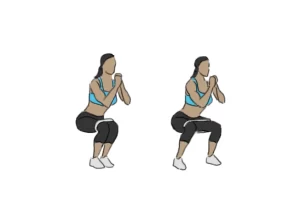
Why it rocks: This is a double-whammy abs buster since you have to truly work your core to keep your chest up and spine long as you change levels.
How to:
Place your hands crossed in front of your chest as you stand with your feet shoulder-width apart.
Sit slowly in a half-squat stance, bringing your hips back and down.
Keeping your hips steady, bring your right knee to the floor first, then your left.
Return to the half-squat position by bringing the right foot forward first, then the left. It’s one rep. Do 10 repetitions.
Cossack Squats
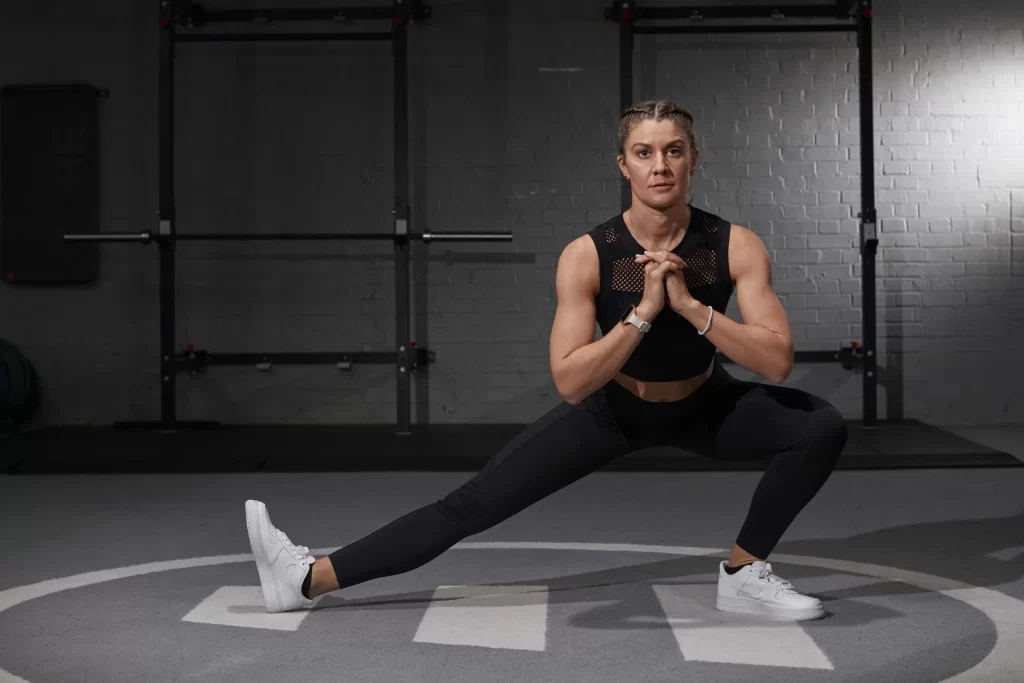
They are a fantastic form of workout for your legs, glutes, and core. You hold a bumper plate or kettlebell in your hands. Cossack squats will test your balance, aid in improving your general stability, and help develop hip and ankle mobility.
Standing with your feet wider apart and your toes pointed outward. Lower your body while maintaining the other leg straight, shifting your weight to that side.
To stand back up, push through the heel of your bowing leg.
On the opposite side, repeat.
Remember to warm up before completing these exercises, stretch before doing them, and seek medical advice before beginning any new workout regimen.
Sissy Squats
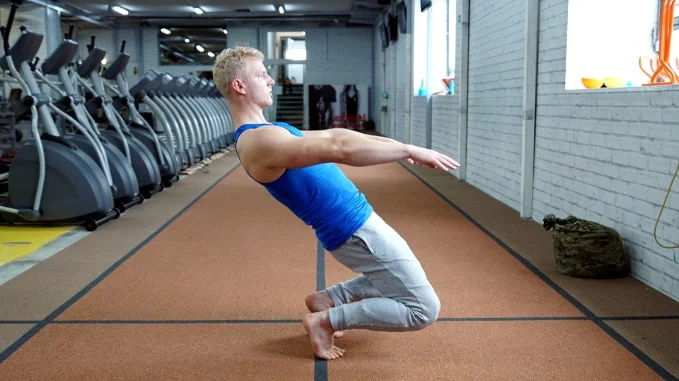
Sissy squats are difficult for people of any fitness level and can be performed without special tools. Although they may take some time to perfect, they are excellent for strengthening the core and improving balance.
Performing sissy squats
Standing with your feet just wider than your hips will help. pointing your toes forward.
Put your hands on your hips (or, for balance, grip onto a chair back or a wall).
Make a straight, sturdy line from your knees to your head by engaging your core, bending at the knees, and leaning back gently.
Maintaining your backward lean, keep bending your knees as close to the earth as you can.
At the bottom, pause before rising.
Perform 10 to 12 reps.
Things to keep in mind
Consider your body as a strong plank from your shoulders to your knees to get the most out of sissy squats. Hip flexion is not something you should do. You can more effectively support yourself when you lower your body to the ground by using your core muscles.
Holding a weight plate on your chest with one arm while balancing on a wall or the back of a chair with the other allows you to further challenge the exercise.
Banded Spanish Squats
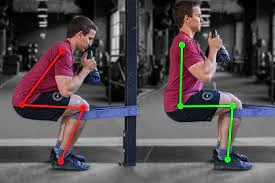
A resistance band is also necessary for the banded Spanish squat. For those who endure knee pain when performing difficult lifts, it is ideal. The resistance band keeps the shins rigidly perpendicular to the ground as you lower yourself into a squat, which aids in stabilizing the knees.
Banded Spanish squat technique:
At knee height, loop or connect a resistance band to a sturdy support (like the leg of a table).
The band should now be around the backs of your knees once you step into it.
When the band is tightly restricted take a few steps back.
Push your hips back and drop yourself into a deep squat while maintaining a tight stance with your feet.
At the bottom, pause for a moment before rising quickly again.
Perform 10 to 12 reps.
Things to Consider
Move back far enough so that the band’s tightness prevents your knees from moving in front of your feet to better protect them. Your lower leg should be 90 degrees perpendicular to the ground as you squat. The knee joint is put under excessive strain when squatting with the knees bent forward.
Banded Spanish squats, when performed correctly, can isolate the quads just as well as a leg extension machine.
squatting with extended legs
Leg extensions done while kneeling are easy but effective. They are perfect for those who struggle with balance because they require no special equipment (other than a floor mat or carpet).
The idea is to apply proper resistance to your quad muscles using only your upper body weight.
Leg extensions when on one’s knees:
Kneel with your feet tucked beneath you and your knees about shoulder-width apart on a mat or carpeted floor.
Cross your arms over your chest while sitting on your heels.
Lean back slowly while contracting your core, maintaining rigidity from your knees to your shoulders.
As far as you can without losing your equilibrium, go back.
Hold for a few periods before straightening out your body again.
Perform 10 to 12 reps.
Things to Consider
Similar to sissy squats, it’s important to keep in mind that as you lean back, your body should be rock-solid like a plank. You’re leaning back too far if your hips collapse.
The same holds if you experience knee pain.
Gradually extend the duration of your hold and lean back more. Your quadriceps will get more flexible as you practice, and your knees will become stronger and more stable.
What should I understand about exercising safely?
Begin gradually. These are beginner activities. If you need to see a physical therapist for more difficult exercises, ask your doctor or other medical professional. You might be able to perform more repetitions of each exercise or add weights as you get stronger.
If pain strikes, stop. At initially, you can experience some discomfort, but the pain is not usual. Over time, regular activity can help reduce your discomfort.
Before performing quadriceps workouts, warm up. Warm up your muscles by walking for 5 or 10 minutes or cycling a stationary bike.
Continue to the fitness program that your doctor has advised. He or she will advise you on the workouts that are most beneficial for your condition. Additionally, they will advise you on regularity and how many repetitions to perform the workouts.
Contraindications:
Despite being a simple beginner’s posture performed with the assistance of the chair, there are a few safety issues to bear in mind when performing the Quad Stretch posture With the Chair. Precautions include:
Ankle, knee, and hip injuries are contraindicated, so these procedures should be avoided.
It is better to prevent injuries to the quadriceps, hamstrings, psoas, gluteus, pelvic floor muscles, and calf muscles as they are also contraindicated. However, if suggested by medical professionals or a therapist as a part of recovery, the same can be done.
The flexed knee can be supported with a block or bolster if doing the Quad Stretch Pose With Chair is still difficult for those with tight quads or psoas. Those who frequently get cramps should be cautious because this stretch may make them worse. Therefore, an elastic band might be used as an alternative to hold the bent leg.
Who Should Not Do Quad Exercises?
One of the strongest muscular groups in the body is the quadriceps. Their mobility may be affected by injury. Due to the synergistic nature of these muscles, damage to one muscle might cause the other muscles to overwork, which can result in tendon diseases and muscle strain. Therefore, before including these workouts in your exercise routine, keep the following in mind:
Avoid performing difficult quad exercises if your quadriceps are weak. Gait speed can be slowed down and stance time prolonged by weak quads. You can initially develop quad strength by performing focused, simple exercises.
Consult your doctor before including these rehabilitation exercises in your training regimen if you have a leg injury, a chronic health condition, a recent operation, or an injury caused during a sporting event.
Summary
For you to stay mobile and balanced, you need strong quadriceps. You can use specific exercises to regain quad strength if you’ve been hurt or have surgery.
Working to maintain strong quads can also help you move as freely as possible and reduce your chance of overuse injuries in sports.
Simple but efficient exercises include straight leg lifts, short arc quads, wall slides, terminal knee extensions, step-ups, and split squats. To make sure you’re performing the exercises properly at first, you might want to work with a physical therapist.
FAQ
How long does it take to build quads from the beginning?
After starting a leg workout, you can begin to see some effects in as little as two to four weeks. Your strength will increase, and your legs will appear somewhat more toned. However, overall, it does take three to four months for any noticeable effect, depending on your level of fitness.
Why are the quadriceps weak?
Quadriceps weakness can be caused by particular conditions and injuries. One of the more significant disorders that affects the quads is quadriceps paresis since it can lead to extreme instability. Weak quadriceps are frequently caused by sports injuries, many of which also harm the rectus femoris muscle.
What quad exercise is recommended?
The back squat, according to Earnest, is the workout that will help you develop the strongest, most powerful, and largest quads. Additionally, it helps you to employ a variety of weights, maximizing the tension on your muscle fibers and stimulating muscle growth. Few restrictions apply here, and who doesn’t enjoy leveling up?
Is it possible to develop quads without squats?
Authentic maintains that there are unique methods to approach your training. Step-ups and walking lunges, for instance, are two outstanding quad-strength exercises. Additionally, they both aid in muscular imbalances and stability.
According to Earnest, the quads are also worked out and strengthened by cardio favorites. Your quads and other muscles are worked during activities like running, stair climbing, cycling, and kickboxing, which also increase cardiovascular endurance.
Why do quads get weak?
Your day’s sitting at a computer for the majority of it is probably to blame. According to Earnest, weak quadriceps might be a result of your lifestyle choices, as well as sedentary work.
If your thighs aren’t as powerful as they may be, you’ll notice. Repetitive pain and injury are two indicators that your quads are weak, according to Earnest. Because daily duties require our lower body power, we must include strength days in our training routine.”
How would you suggest strengthening the quadriceps?
It truly doesn’t take as long as you might imagine to increase your quad strength. Earnest advises exercising your legs one to two times a week, with a minimum of three days of recovery in between. This enables us to get the most out of our workout by giving our muscles time to rest and regenerate before our next session.
Combining bodyweight exercises and weights has advantages. “II like including bodyweight exercises into my lower body circuits even though using dumbbells may result in stronger, quicker muscles,” says Earnest. Bodyweight not only helps us develop good form when under tension, but it also significantly improves our flexibility and mobility, which lowers the risk of injury.
Reference
- Yetman, D. (2023, May 23). 10 At-Home Exercises to Strengthen and Tone Your Quads. Healthline. https://www.healthline.com/health/best-quad-exercises
- Sayer, A. (2023, September 29). 10 effective quad exercises you can do at home. The Manual. https://www.themanual.com/fitness/exercises-you-can-do-at-home-to-target-your-quads/
- The 14 Best Quad Exercises To Strengthen And Sculpt The Legs, According To A Trainer. (2023, March 22). Women’s Health. https://www.womenshealthmag.com/fitness/a19981853/quads-exercises/
- Inverarity, L. (2023, August 31). 11 Quad-Focused Exercises for Strength and Muscle Building. Verywell Health. https://www.verywellhealth.com/quad-strengthening-exercises-2696617
- Williams, P. (2020, July 28). The 10 Easy Quad Exercises For Beginners. Muscle & Fitness. https://www.muscleandfitness.com/workouts/leg-exercises/10-best-quadriceps-exercises-beginners/
- Halse, H. (2021, January 21). The Best Quadriceps Exercises at Home. LIVESTRONG.COM. https://www.livestrong.com/article/376140-quadriceps-exercises-at-home/

